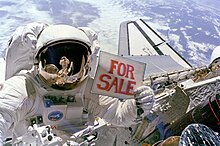Dale Gardner
This article needs additional citations for verification. (February 2014) |
Dale Gardner | |
|---|---|
NASA astronaut | |
| Rank | Captain, USN |
Time in space | 14d 0h 52m |
| Selection | NASA Group 8 (1978) |
Total EVAs | 2 |
Total EVA time | 12h 14m |
| Missions | STS-8 STS-51-A |
Mission insignia | |
| Retirement | October 1986 |
Dale Allan Gardner (November 8, 1948 – February 19, 2014) was a NASA astronaut, and naval flight officer who flew two Space Shuttle missions during the mid 1980s.
Personal information
Born on November 8, 1948, in
.Education
Gardner graduated as
Military experience
Upon graduation from the
NASA experience
Gardner was selected as an astronaut candidate by NASA in January 1978, reporting to the Johnson Space Center in July 1978. In August 1979 he completed a one-year training and evaluation period, making him eligible for assignment as a Mission Specialist Astronaut. He subsequently served as the Astronaut Project Manager for the flight software in the Space Shuttle onboard computers leading up to the first flight in April 1981. He then served as a Support Crew Astronaut for the fourth flight (STS-4). He flew as a mission specialist on STS-8 (August 30 to September 5, 1983) and STS-51-A (November 8–16, 1984). Gardner logged a total of 337 hours in space and 225 orbits of the Earth on these two flights.
He logged more than 2,300 hours flying time in over 20 different types of aircraft and spacecraft. Prior to the
In October 1986, following 8½ years with NASA, Gardner returned to his
Space flight experience

Organizations
Gardner was a Member of Phi Eta Sigma, Sigma Tau, and Tau Beta Pi, and a fellow of the American Astronautical Society.
Special honors
Gardner was awarded the
A bridge connecting
Death
Gardner died on February 19, 2014, after suffering a hemorrhagic stroke at his home. He was 65.[3][4]
References
- ^ a b "Dale Allan Gardner Obituary". The Gazette. February 22, 2014. Retrieved February 22, 2014.
- ^ "New Savanna bridge will open Friday | SaukValley.com". www.saukvalley.com. Archived from the original on November 16, 2017.
- ^ "Dale Gardner, jetpack-flying astronaut who salvaged satellites, dies at 65 - collectSPACE". collectSPACE.com. Retrieved October 6, 2014.
- ^ Yardley, William (February 28, 2014). "Dale Gardner, Astronaut Who Helped Corral Wayward Satellites, Dies at 65". The New York Times.
- "Biographical data: DALE A. GARDNER NASA ASTRONAUT (DECEASED)" (PDF). NASA. February 2014. Retrieved February 3, 2021.
External links
